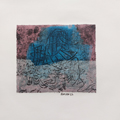textes / cv
2008-10
A propos / artist statement, 2009
____________________________
About drawing , painting...
After a figurative period, I introduced, within my pictorial practice, a rupture with the unitary surface of the painting and I chose to systematically work in dyptichs.
The rupture of the unity of the painting, materialized by working on different panels, had for objective to conceive painting as a never ending process , where no border imposed by the geometrical constraints of the support , would enclose , break down , or channel the constant flow of inspiration and emotion. This state of release and relaxation allowed me to engage my painting in the experimentation of its prime vocation which is working on the appearing, on the visibility of the world, visibility created from within by the genesis of pictorial elements and by their ability to generate the visual phenomena. It was only in a second stage that I let the panels confront each other, and I assembled them when I felt an attraction between them, when they emitted a common emotional field.
About 15 years of this practice of the diptych , allowed me later , to return to a unitary surface and to work on paper in that same mental state of “ non project “ : to paint without creating paintings.
As I get older I notice that what ties us to life is materiality. And that link is made through plasticity. My creation belongs to the order of the plastic, it is through plasticity that I start up my mind. It is my way of relating my spirit to my life in this world, it is my way of being in this world.
I am not a narrator, even if through my paintings or drawings, there is, many times at a given moment, the possible emergence of a figure, or a landscape or of things that might be recognizable as being part of an identifiable visual universe. But these phenomena happen like apparitions, not as voluntary actions. One must understand that the constituent elements are abstract, that is to say that a face, a body, nature are not the actual thing in the painting process. Tree is not a tree, face is not a face. It’s the configuration of the elements which are themselves abstract and that the viewer will then organize into groups. With spots, dots, strokes, lines, color masses, transparencies, opaqueness, translucence, I obtain configurations that through a game of transposition receive the qualities of recognizable objects. I proceed with something that brings me closer to what is for me the origin of pictorial art.
After a figurative period, I introduced, within my pictorial practice, a rupture with the unitary surface of the painting and I chose to systematically work in dyptichs.
The rupture of the unity of the painting, materialized by working on different panels, had for objective to conceive painting as a never ending process , where no border imposed by the geometrical constraints of the support , would enclose , break down , or channel the constant flow of inspiration and emotion. This state of release and relaxation allowed me to engage my painting in the experimentation of its prime vocation which is working on the appearing, on the visibility of the world, visibility created from within by the genesis of pictorial elements and by their ability to generate the visual phenomena. It was only in a second stage that I let the panels confront each other, and I assembled them when I felt an attraction between them, when they emitted a common emotional field.
About 15 years of this practice of the diptych , allowed me later , to return to a unitary surface and to work on paper in that same mental state of “ non project “ : to paint without creating paintings.
As I get older I notice that what ties us to life is materiality. And that link is made through plasticity. My creation belongs to the order of the plastic, it is through plasticity that I start up my mind. It is my way of relating my spirit to my life in this world, it is my way of being in this world.
I am not a narrator, even if through my paintings or drawings, there is, many times at a given moment, the possible emergence of a figure, or a landscape or of things that might be recognizable as being part of an identifiable visual universe. But these phenomena happen like apparitions, not as voluntary actions. One must understand that the constituent elements are abstract, that is to say that a face, a body, nature are not the actual thing in the painting process. Tree is not a tree, face is not a face. It’s the configuration of the elements which are themselves abstract and that the viewer will then organize into groups. With spots, dots, strokes, lines, color masses, transparencies, opaqueness, translucence, I obtain configurations that through a game of transposition receive the qualities of recognizable objects. I proceed with something that brings me closer to what is for me the origin of pictorial art.
From Ernesto Riveiro 's interview by Marcin Sobieszczanski, Université de Nice Sophia-Antipolis.
in "Les artistes et la perception", Marcin Sobieszczanski, éditions Lharmattan 2002.
and "Les demeures du paraître", édition "le 19", Centre régional d'art contemporain de Montbéliard 2009.
Translation Dominique Ashby and Arturo Villaamil.
in "Les artistes et la perception", Marcin Sobieszczanski, éditions Lharmattan 2002.
and "Les demeures du paraître", édition "le 19", Centre régional d'art contemporain de Montbéliard 2009.
Translation Dominique Ashby and Arturo Villaamil.














